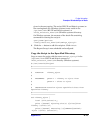
Further Information
Performance Considerations
Appendix A A-13
If you suspect that the sustained data flow to the tape device is too
low or that the device does not handle it correctly, you can simulate a
very fast device on the Media Agent client by doing the following:
1. Create a standalone file device and a device file /dev/null on
UNIX and nul on Windows.
2. Create a separate pool and select loose policy.
3. Set InitOnLoosePolicy=1 and set data protection to None.
Perform backups to this device and check if the performance
discrepancy between backups to the file device and backups to the
real device can be explained.You can also run the vbda locally and
write directly to a file. Run the commands listed below:
On HP-UX and Solaris:
/opt/omni/lbin/vbda -vol /home -trees /home/jdo -
out /dev/null -profile
On Windows:
<Data_Protector_home>\bin\vbda -vol /C -trees
"/Program Files/OmniBack/bin" -out nul -profile
On Novell NetWare:
load sys:usr\omni\bin\hpvbda.nlm -vol /sys -tree
/usr/omni -out \tmp\test
• Device configuration
Adjust the device block size if necessary.
• CRC option
CRC option impacts performance due to the CRC calculation, which is
performed by the Media Agent client.
• Logging and Report Level
If an update of the IDB takes too long, disable logging by setting it to
Log None. The same way you can filter messages by setting the
Report level to Critical.
• Data Protector Application Clients
If a restore session of the Application clients (Oracle, SAP R/3) takes
too long, decrease the SmWaitforNewClient value, which is by default
5 minutes. Set it to a lower value.





















